All of life’s little pleasures that we take for granted, like cooking and eating our favorite foods, will undergo some drastic changes when disaster strikes. Without electricity or other sources of commercial fuel, modern gas and electric stoves are nothing more than scrap metal.
To survive these times you need to know how to use alternative cooking methods that are hard to detect. No matter whether people turn into thieves out of desperation, or you are on the run from other hostile forces, cooking under the radar will be just as important as any other tool in your survival chest.
Getting Around the Pitfalls of Open Fires
It is not a good idea to use an open fire pit in a time when you are trying to be off the grid and under the radar. In the daylight the smoke from the fire can easily be seen miles away. At night the glow of the hot coals can make the camp visible.
In addition, the large size of an open fire pit can leave an enormous heat signature that can easily be picked up by drones and any other equipment that uses thermal sensors.
If you must use an open fire pit do so in either a cave or an old mine. Both of these locations will hide the smoke and the glow of the coals. Before you move into the cave or a mine, scout it out. Locate all entrances and possible air shafts and camouflage them.
Be careful when exploring these areas, because they may already be inhabited by bears, mountain lions, bats, or other animals who may not want to share their home. If these areas are clear, you have a safe place to cook and live.
Using Chemical Heating Tablets

These foods have the advantage of a very long shelf life, and some can also be consumed cold. To cook MRIs you can use chemical heating tablets.
Simply add water to the heating pouch with the heating tablet, and then put the food to be heated in the pouch. In a few minutes the food will be warm.
These tablets have limited use outside of what they were designed to do and cannot be used to start an ordinary camp fire.
Make Your Own Hobo Stove
Hobo Stoves were used during the Great Depression by poor people to cook simple meals.
A Hobo Stove is easy to make from two empty food cans and a piece of heavy gauge wire. The larger of two cans is used as the outer frame, with heavy gauge wire was attached to make the resting place for a pot or pan. The outer can has a few holes cut in it near the bottom to form a draft for the inner can, which also has holes cut all around it. The smaller can acts as the fire box.
To use this stove, just put paper or small sticks in the inner can and light it. When the fire is burning good, put your cooking pot on top of it and heat your meal.
The Hobo stove can also be used to keep you warm when the cooking is done. Be sure to use it in a well vented area. Because the can holds the fire in a very small space, it has a smaller heat signature and also produces less smoke.
You can also put a screen or other diffuser well above the hobo stove to break up the smoke and light from the fire.
Dakota Fire Pits
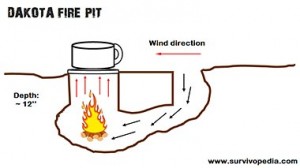
Then, place fire wood in one tunnel and light it. The two vertical shafts create a draft in the tunnel to keep the fire going. When you have a good bed of coals in one shaft, it is time to cook.
Put your cooking pot over the empty vertical shaft and let the heat from the tunnel cook the food. This method of cooking can be done in semi- open areas because of the small amount of visible smoke.
Also, because the hot coals are underground it is very hard to see them.
Solar Cooking With a Water Lens
Even though solar cookers do not require smoky fires, they can easily be detected because of the reflective surface on the light collector. To get around this, attach a heavy piece of clear plastic on poles and let the center section cave in. Pour water into the central portion to make the heat collecting lens. From there, simply place your food under the lowest portion of the plastic canopy. Using black mason jars inside an oven roaster bag will improve heat retention and speed up cooking.
To disguise the presence of this system as much as possible, use near a body of water and as close as possible to a tree line. In this way, drones or other airborne vehicles will mistake any stray glare from the system to the water they see nearby. You should also make sure that you set up this system away from trails or other natural pathways that other people might use to get to your area in search of food or water.
Even though heating foods is an absolute necessity, you will find it a bit challenging to cook off the grid and under the radar.
While there is no perfect method, you can use a few simple and inexpensive tools to reduce heat and visibility signatures as much as possible. Choosing those that offer the greatest mobility will also be of benefit if you are planning to travel over large distances or you know that you are going to be in a bad area.

Photo source: 123RF


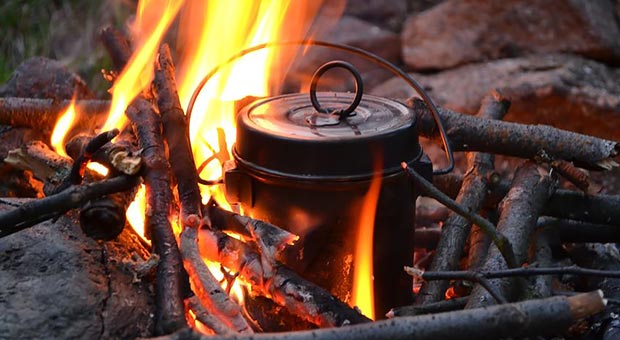
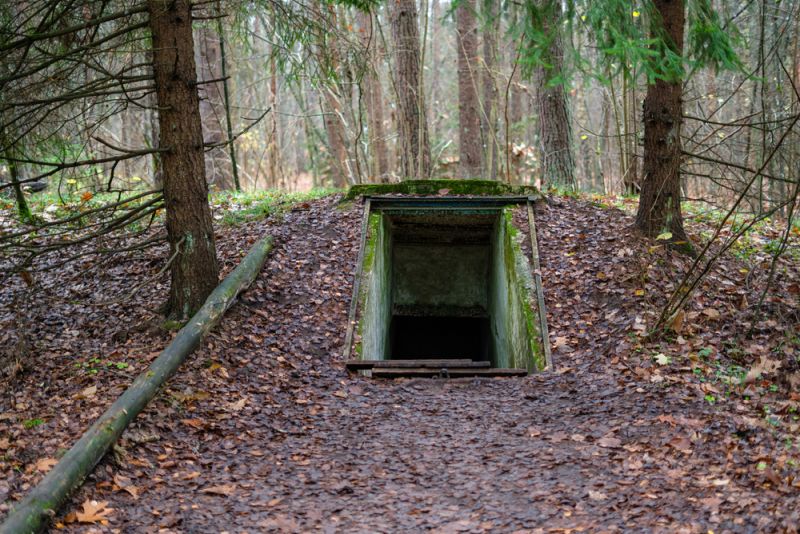
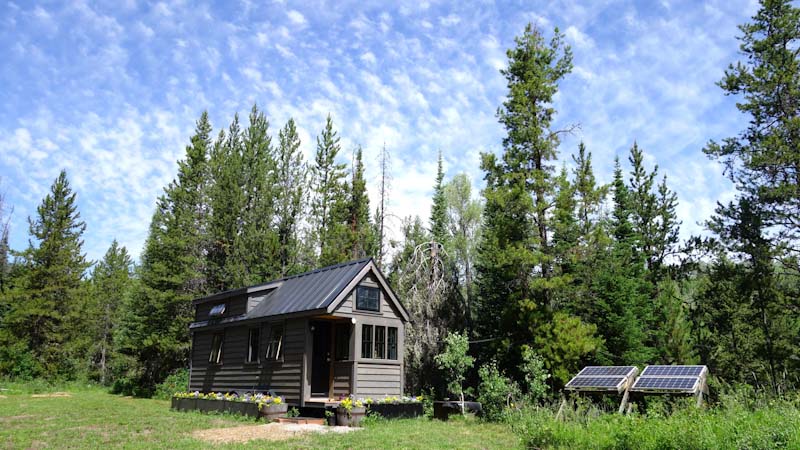

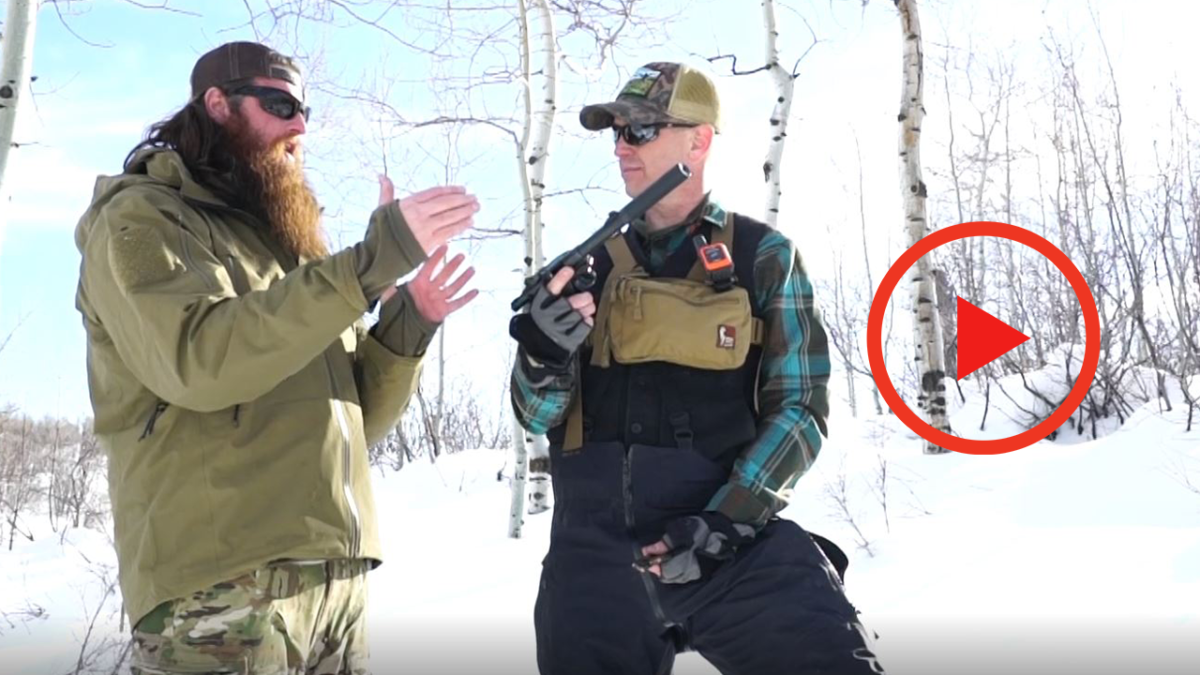


ChewbyKA | March 21, 2014
|
Greetings
Here is a design for a rocket stove that uses five concrete blocks (concrete masonry units/cement blocks/breeze blocks.) Rocket stoves use minimal fuel, direct heat to the point of use and produce little smoke, the five block rocket stove is very easy to assemble and concrete blocks are ubiquitous in the urban environment and readily available
http://the-pragmatic-stoic.blogspot.co.nz/2012/08/design-five-block-rocket-stove.html
Chew
ken | March 21, 2014
|
How about an article on how to defeat thermal imaging.
Rod | June 19, 2014
|
That would be an Excellent topic for folks if they have to bug out, especially with Drones searching.
Bilge Pump McCoy | December 25, 2016
|
I have a Flir thermal scope and I have been playing with a way to defeat it for well over a year now. But after numerous tests with family members as “volunteers”, I’m convinced that actually defeating it with space blankets, wool blankets, heavy clothes, and other such masking techniques is not possible. Glass is a problem for thermal but its not practical to bug-out with a sheet of glass so I am not considering that as an option. I have concluded that the best way to deal with the thermal problem is to work on stealth hiding techniques in combination with heat signature masking methods. For instance, if you must travel at night, consider wearing a loose fitting heavy jacket to mask some of your heat signature, and move deeper into the woods and away from roads and trails where people might be scoping the area. I wouldn’t worry too much about drones. Unless you are the subject of a massive manhunt, I don’t think the government will be willing to waste drone resources looking for Joe Blow who is trying to get from point A to point B.
Pingback:Cooking Off the Grid and Under the Radar | TheSurvivalPlaceBlog | March 21, 2014
|
Todd | March 22, 2014
|
Good article. The author’s comment on building a fire in a cave or mine reminds me of a childhood adventure. Some friends and I knew of a LARGE drain pipe that funneled storm water under the road and under the property of a factory. It was probably a half mile long and 6 feet wide. We decided to build ourselves a campfire in there figuring that the smoke would rise to the top of the pipe and find its way out both ends. WRONG! Smoke filled the whole dang pipe in what seemed like only two minutes. Lesson learned, don’t build a fire in a mine!
Pingback:Packing Weight for Bugging Out on Foot | June 18, 2014
|
Pingback:Packing Weight for a Smooth Bug-Out | Rowan Oath Keepers | June 18, 2014
|
Pingback:Packing Weight for a Smooth Bug-Out | TheSurvivalPlaceBlog | June 20, 2014
|
Pingback:How to Fish for Your Off-grid Survival | June 27, 2014
|
Pingback:Firecraft: 6 Survival Fire Starters | Survival skills, survival guns, survival guide | November 5, 2014
|
Pingback:Surviving An EMP Attack: Part Three | Survival skills, survival guns, survival guide | January 8, 2015
|
Pingback:15 Ways To Cook Without Electricity | Survival skills, survival guns, survival guide | August 17, 2015
|
Pingback:15 Ways To Cook Without Electricity | Survival skills, survival guns, survival guide | August 17, 2015
|
Pingback:6 Basic Recipes To Prepare Off-Griddisasterdefense.us | disasterdefense.us | October 20, 2015
|
Pingback:6 Basic Recipes To Prepare Off-Grid | October 22, 2015
|
Pingback:Off-Grid Winter: How To Generate Power On Ice | Prepper's Survival Homestead | February 2, 2016
|
A.L.Howes | May 12, 2016
|
Some of us are older women with small hands who are not able to get down on our knees to the ground. Some may be widows living alone. I don’t think we are being taken into consideration. Which stove would be the easier one for us ? Every one who comes to your site is not a working younger man with a family.
Please consider us as well. Thanks!
Pingback:Pressure Canning: 7 Survival Meals In A Jar | Prepper's Survival Homestead | June 20, 2016
|
Pingback:6 Basic Recipes To Prepare Off-Grid | Survivopedia | June 21, 2016
|
Pingback:13 Multi-Use Survival Items You Can Find At The Dollar Store | Survivopedia | July 15, 2016
|
Pingback:The 7 Rules Of How Not To Become A Target | Survivopedia | November 14, 2017
|